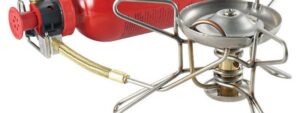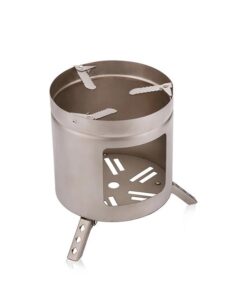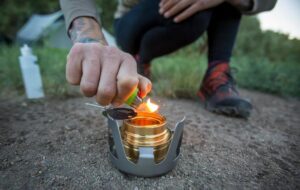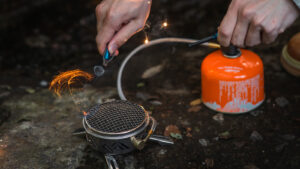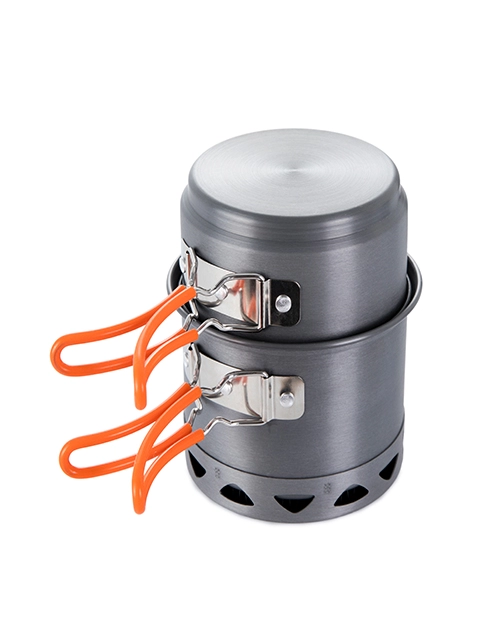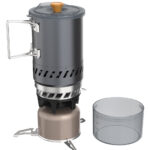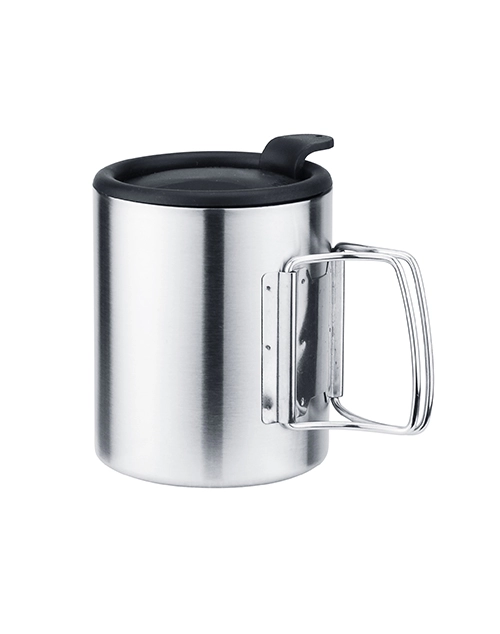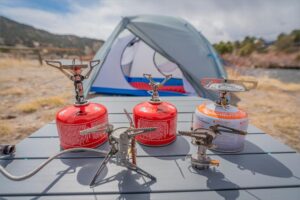
Canister Camping Stoves
Canister stoves are the most popular variety among travellers because to its efficiency, ease of use, and portability. Fuel canisters (available in 4-, 8-, and 16-ounce capacity) are preloaded with a pressurized mixture of isobutane and propane. To use, screw the canister into the stove, open the valve, and fire the burner. Simple as that. Canister stoves burn very cleanly and are the most efficient way to boil water. Some can simmer as well. Furthermore, they are often lighter and more compact than liquid fuel stoves. For hikers who want to maximize space and efficiency, the canister stove is an excellent solution.
How To Use Canister Camping Stoves:
This sort of stove is the most user-friendly of all those mentioned in this article. Simply keep it on a level surface when using it. Setting it up is simple: screw the canister onto the stove and it’s ready to use.
The Pros and Cons
Pros:
- They are small and lightweight.
- They are quick to ignite. No priming is required before igniting a canister stove. Simply turn the valve to ignite using a match, lighter, or piezo-igniter.
- Most models include easy-to-adjust flames and excellent simmering capabilities.
- The canister self-seals while unscrewing the burner, preventing spills and leaks.
- Canister stoves with built-in pressure regulators offer steady heat output throughout time. This also increases performance in colder conditions and at higher elevations.
Cons:
- Their arms may not be long enough to hold heavy pots safely.
- To avoid running out of gas, have a spare canister on hand as it might be difficult to determine how much is left inside. (A little 4-ounce jar makes a good backup.)
- Do not use a windshield with an on-canister burner as it can trap excessive heat and cause fuel to explode.
- Cold weather can cause canisters to depressurize, resulting in a feeble flame (unless the stove includes a pressure regulator).
- In comparison to liquid-fuel stoves, fuel costs are higher.
- Dispose of empty canisters appropriately by researching local recycling sources.
Liquid Fuel
Canister stoves are perhaps the most common choice among travelers, but liquid and multi-fuel stoves also have their uses. These variants include a refillable fuel container connected to the stove via a fuel line. All liquid stoves operate on white gas, a highly refined, clean, and hot-burning fuel available at most outdoor and hardware stores (and less costly per ounce than canister fuel). Some liquid fuel stoves may burn a variety of fuels, including kerosene and unleaded gasoline. For this reason, liquid and multi-fuel stoves are perfect for international travel.
How To Use Liquid fuel
This style of stove operates by connecting a fuel bottle to it. Unlike the previously described canister, liquid gasoline is not compressed, thus you must increase the pressure within. Flames are caused by the vapors produced by liquid fuels rather than the fuel itself. This implies that the liquid gas must first evaporate before it can burn.
Pros:
- Liquid-fuel stoves are low-profile and stable on uneven ground.
- The fuel bottle allows for easy monitoring of remaining fuel.
- Requires a fuel bottle, but eliminates the need for a canister.
- Outperforms other stoves at high heights and in freezing weather.
Cons:
- Priming and maintenance are necessary.
- Fuel spillage is conceivable.
- They are often heavier than canister stoves.
- Multi-fuel stoves may cost extra.
- Fuels other than white gas include contaminants that might block stove components like the fuel tube.
They burn twigs and leaves you gather in the woods, you don’t need to carry fuel, which is ideal for longer or lighter treks. Finally, wood-burning stoves (like the 4.1-ounce Vargo Titanium Hexagon Wood Stove) are powered by biomass—sticks, twigs, bark, and grass—so you won’t need to bring fuel with you. Alternative-fuel stoves are useful for lengthy trekking journeys with minimal resupply options due to their use of relatively lightweight (or in situ) fuels. However, they cannot compete with liquid fuel or canister stoves in terms of efficiency, heat production, boil times, and flame control. Furthermore, in rainy weather, starting these stoves may be difficult, and keeping the flame going requires regular care. Lastly, alternative fuels are restricted in some locations.
How To Use Wood Camping Stoves
Starting a fire with a wood-burning stove is similar to lighting a campfire. You’ll need to gather tinder and kindling, as well as larger pieces of wood to use as fuel.
Pros:
- Simple and lightweight options include a foldable titanium base, windshield, and pot support.
- Certain versions may generate enough power from burning twigs to charge a phone or other small device via USB.
- Certain versions provide an optional grill.
Cons:
- Finding dry fuel in rainy conditions might be tricky.
- Use may be banned during fire bans or at high elevations (e.g., Yosemite restricts twig-burning stoves beyond 9,600 feet).
Alcohol Stoves
a tiny metal-based alcohol stove. These stoves are particularly appealing to lightweight trekkers since they weigh only an ounce or two. Furthermore, you simply need to bring a bottle of alcohol that is sufficient for your vacation. Alcohol stoves use denatured alcohol (which can be bought virtually anyplace) and may be created in its most basic form by punching holes along the lip of a tuna fish or a cut-off soda can. Solid fuel tablet stoves run on lightweight tablets that burn for around 12 minutes each.
How To Use Alcohol stoves
The alcohol stove is easy to use. Simply pour in the gasoline and fire it up. Cooking begins when blue flames appear from the ventilation openings.
Pros:
- Denatured alcohol stoves have minimal components that need maintenance.
- Denatured alcohol is affordable and widely available in the United States.
- The fuel burns quietly.
Cons:
- Boiling water with alcohol takes longer and uses more fuel due to its lower burning temperature compared to canister or white gas.
- A windshield is often necessary.
- Denatured alcohol is difficult to get outside the US.
ODM service
Looking for reliable camping stove supplier? At Deermaple, we specialize in ODM service, offering high-quality and innovative stoves tailored to your needs.
If you are interested in camping stove wholesale , please contact us.

